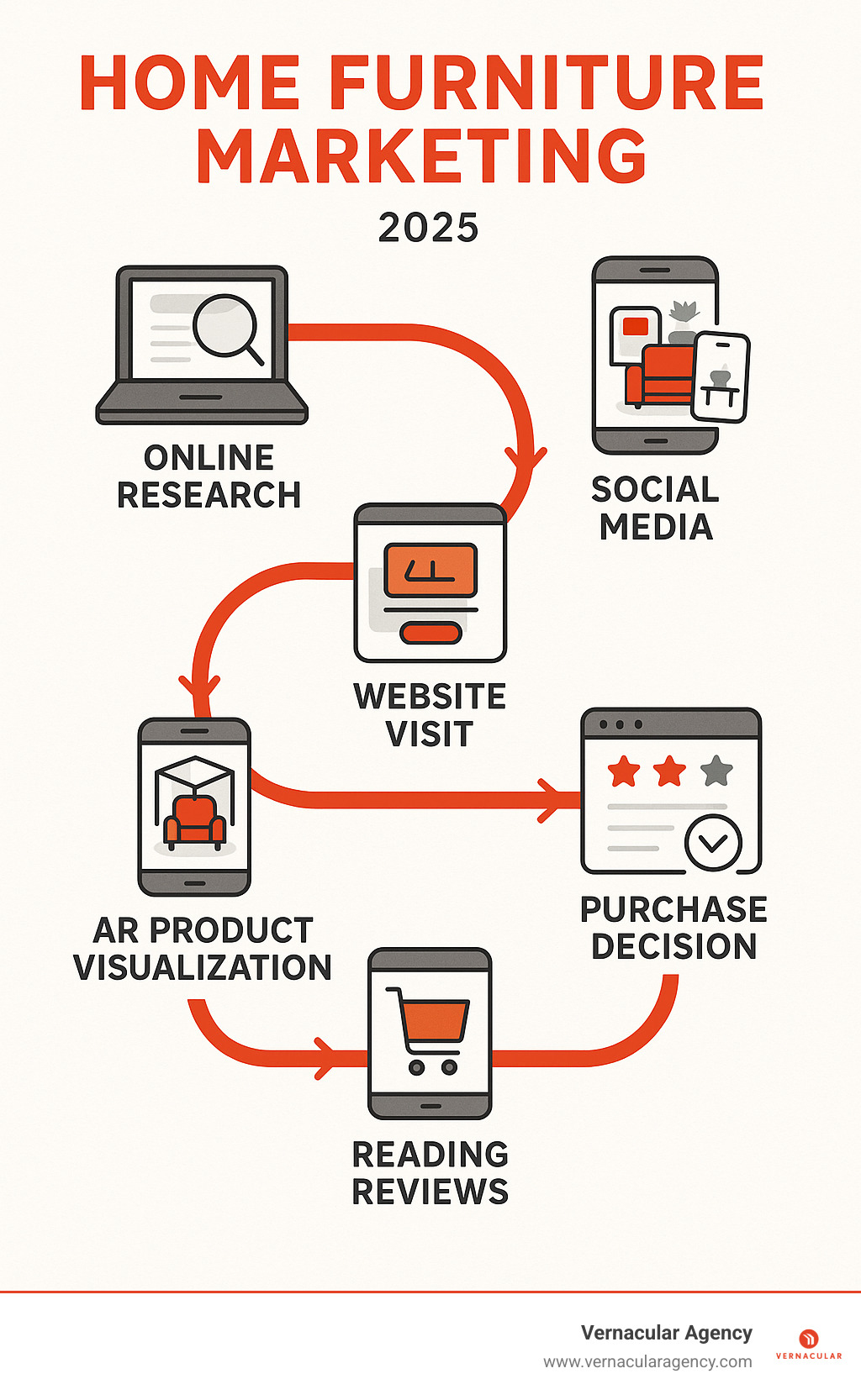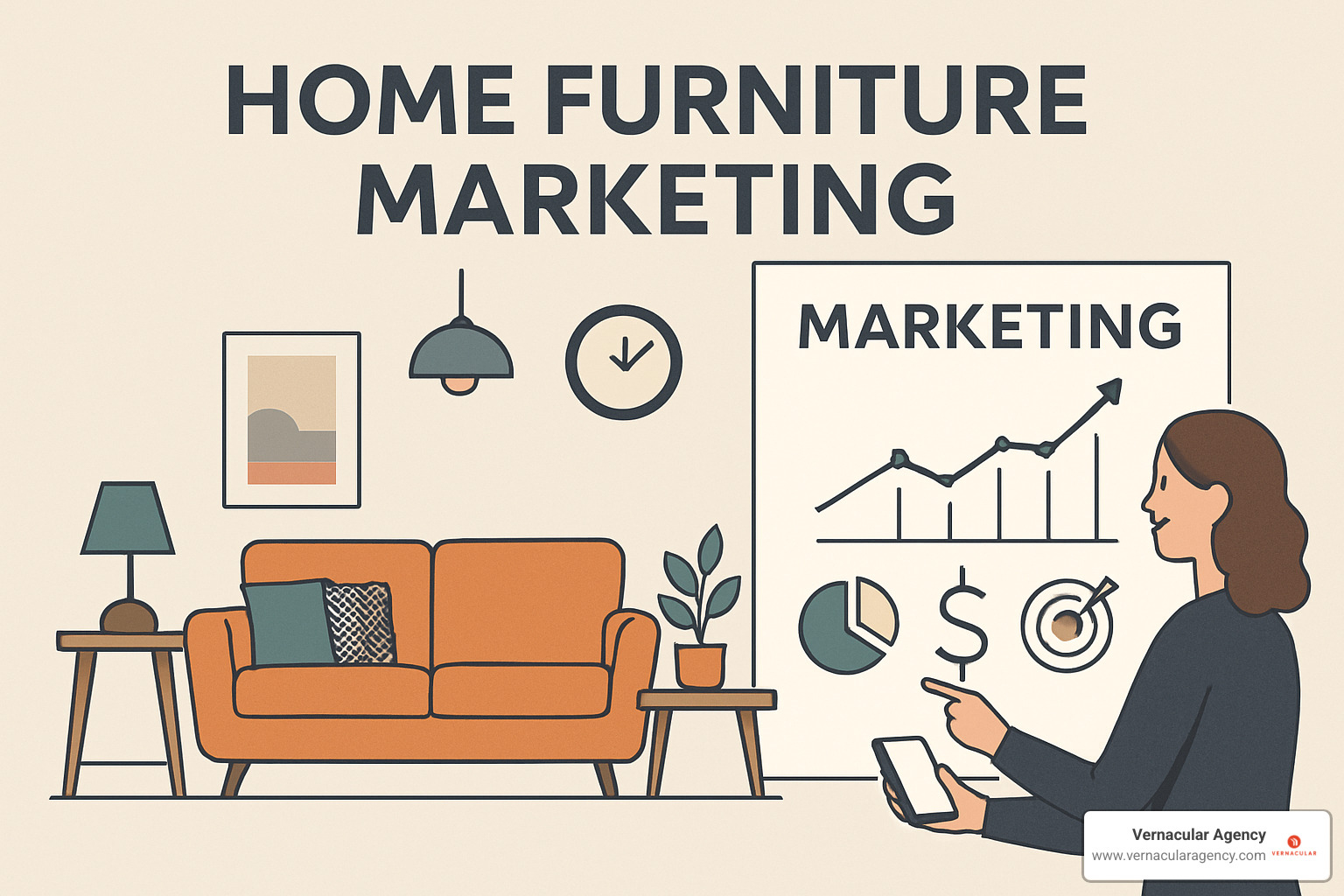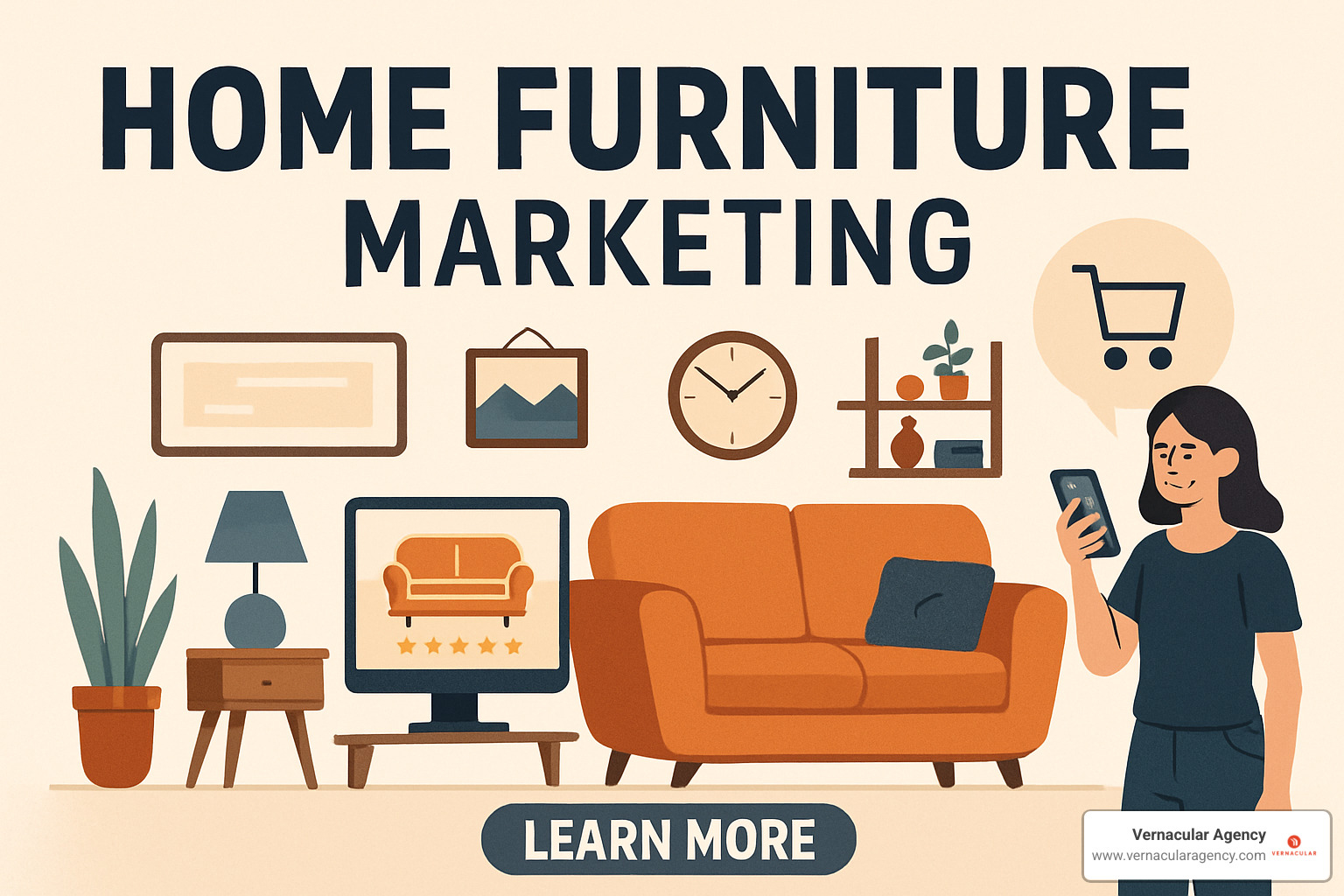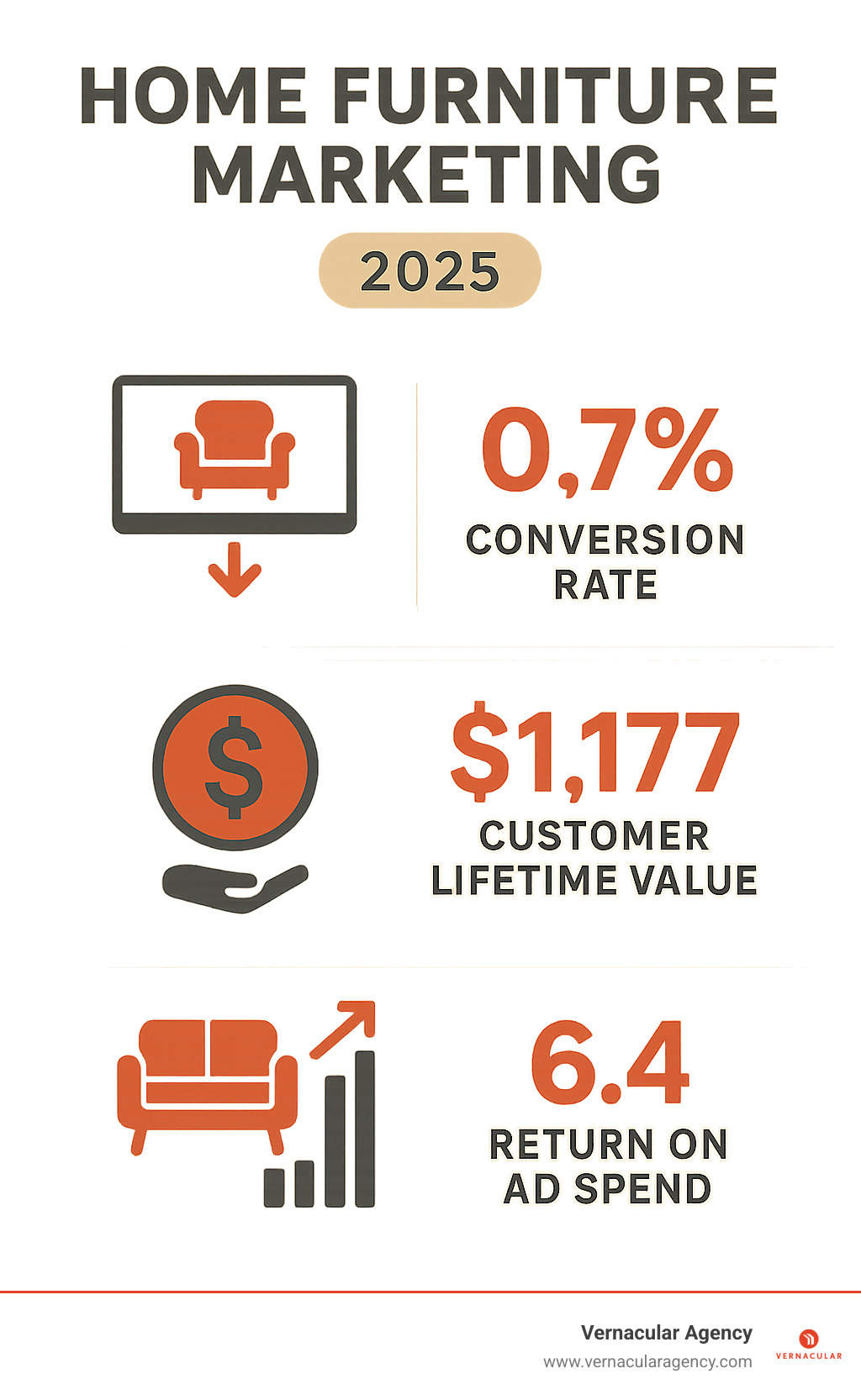Home furniture buying is now a digital-first journey. Research shows that 87 % of shoppers start online and 92 % read reviews before spending. If your brand isn’t visible, fast, and inspiring on the web, you lose the sale before the customer ever reaches a showroom.
Key elements of winning home furniture marketing
Why now? Remote work has people upgrading their spaces, 65 % of buyers will pay more for sustainable pieces, and AR users convert up to 8× better than non-AR shoppers. Analysts expect global online furniture sales to hit $430 billion by 2029.
As Rebecca Falzano, Creative Director at Vernacular Agency, I’ve seen brands skyrocket simply by crafting clear stories and friction-free digital experiences. The stakes are high, but the opportunity for growth has never been bigger.

Furniture-marketing vocab to know:

Before tactics comes strategy. Furniture buyers zig-zag from Pinterest to Google to showrooms, so brands must decide who they serve and why customers should care.
Only 11 large companies own 55 % of the U.S. market, leaving plenty of room for niche players that articulate a clear unique selling proposition (USP): maybe eco-certified wood, modular pieces for small spaces, or concierge-level service. Clarify that promise first; everything else aligns to it.
Not all buyers look alike:
Dig beyond demographics into lifestyle values—sustainability, tech-integration, DIY pride—and note where each segment hangs out online. Instagram and Pinterest inspire; Facebook communities answer questions; review sites reassure.
Marketing to movers is especially lucrative: movers spend 3.4× more on furniture within six weeks of relocating. Timed direct-mail or paid-search campaigns capture this spike in demand.
Get the brand bedrock right and channels become far easier to execute. Need help? Explore Vernacular’s brand identity services.

Your website is the new showroom—open 24/7 and visited by most customers before they walk through your doors. Up to 87 % begin research online, so slow pages or confusing layouts equal lost sales.
Key pillars of a conversion-ready site
Platforms like Shopify, BigCommerce, or WooCommerce can all work—what matters is speed, inventory sync, and room for AR features. As your catalog grows, a Product Information Management (PIM) tool keeps specs consistent everywhere.
Vernacular’s SEO & Website Optimization service melds design flair with ranking power, turning browsers into buyers.

Shoppers can’t sit on a sofa through a screen, so visuals must do the heavy lifting. Invest in:
Quick, helpful clips build confidence—recliner demos, extension-table reveals, or 60-second assembly guides. Customer testimonial videos add social proof, while behind-the-scenes footage highlights artisan quality. Host on YouTube (second-largest search engine) and embed on product pages.
Augmented reality lets buyers drop a chair into their actual living room; users of AR tools convert up to 8× more and return fewer items. Virtual showrooms create curated spaces without square-footage costs.
Our team produces these assets via content creation & creative direction.
| Feature | Traditional Online | AR-Improved |
|---|---|---|
| Visualization | Static photos | 3D placement in real room |
| Size clarity | Specs only | True-to-scale view |
| Avg. conversion | 40–60 % | 80 %+ |
| Avg. returns | 15–30 % | 8–15 % |
The best campaigns feel consistent wherever shoppers meet you—Instagram, email, Google, or connected TV. Use each channel for its strength.
Vernacular’s digital marketing programs stitch these together so creative, targeting, and analytics all point at one goal: revenue.
Instagram Reels, Pinterest boards, and TikTok makeovers drive findy—especially when paired with branded hashtags for user-generated content. Partner with creators whose aesthetic matches yours; influencer-led campaigns often convert 2–3× better than standard ads.
Offer a design guide or discount to grow your list, segment by interest (bedroom vs. outdoor), and automate welcome, cart-abandon, and post-purchase series. Paid search wins ready-to-buy traffic; display and CTV show your collection in high-definition environments and allow precise demographic targeting.
Need help weaving it together? Our email marketing experts can build a full funnel that keeps your brand top of mind until shoppers are ready to click “buy now.”

The sale is just the beginning of a successful home furniture marketing strategy. What happens after customers click "buy now" determines whether they become one-time purchasers or lifelong brand advocates who drive sustainable business growth.
Here's something that might surprise you: 65 percent of a company's business comes from existing customers. This statistic becomes even more powerful in furniture retail, where customers make infrequent but high-value purchases that can span decades.
Think about your own furniture buying habits. When you find a brand that delivers quality products, exceptional service, and stands behind their promises, you remember them. You recommend them to friends moving into new homes. You return when you need to furnish additional rooms or upgrade pieces.
This loyalty doesn't happen by accident. It requires intentional strategies that nurture relationships beyond the initial transaction. Customer retention costs five times less than acquisition, making loyalty programs and engagement strategies some of the most profitable investments you can make.
Post-purchase experience sets the foundation for long-term relationships. From delivery coordination to assembly support to care instructions, every touchpoint reinforces your brand's commitment to customer satisfaction. Exceptional service transforms customers into brand ambassadors who provide authentic recommendations worth more than any paid advertising.
Data analysis reveals the story behind your success. Understanding which marketing channels drive the most valuable customers, which products generate repeat purchases, and which customer segments provide the highest lifetime value helps optimize your entire marketing strategy.
Building genuine customer loyalty requires understanding what motivates furniture buyers beyond their initial purchase. Unlike fast-moving consumer goods, furniture purchases are emotional investments that customers live with daily.
Loyalty programs work differently in furniture retail than in other industries. Since customers don't buy sofas monthly like they buy coffee, traditional point-accumulation programs need creative adaptation. The most successful furniture loyalty programs focus on relationship building rather than transaction frequency.
Consider offering exclusive access to new collections, early sale notifications, or complimentary design consultations for loyalty members. These benefits feel valuable even during the long periods between purchases. Tiered programs work well, with benefits increasing based on total lifetime spending rather than recent activity.
Referral rewards tap into the natural tendency to share furniture findies with friends and family. When someone compliments your dining table, you naturally want to share where you found it. Formal referral programs amplify this behavior with incentives for both parties - existing customers receive credits or discounts while new customers get welcome bonuses.
Make referral sharing effortless through social media integration and personalized referral codes. Track referral success and celebrate customers who become brand advocates. Some furniture retailers find that referred customers have 25% higher lifetime value than those acquired through paid advertising.
Flexible financing options remove barriers while building relationships. Offering payment plans, lease-to-own programs, or partnerships with financing companies helps customers afford higher-quality pieces. Transparent terms with no hidden fees build trust and position your brand as customer-focused rather than purely profit-driven.
Transparent return policies demonstrate confidence in your products while reducing purchase anxiety. Furniture returns involve logistics challenges, but clear policies with reasonable return windows help customers buy with confidence. Many customers who initiate returns end up exchanging for different pieces, maintaining revenue while building trust.
User reviews create ongoing engagement opportunities long after delivery. Follow up with customers requesting feedback, respond professionally to all reviews, and use insights to improve products and services. Positive reviews become powerful social proof for future customers navigating their own purchase decisions.
Effective measurement goes beyond vanity metrics to focus on data that drives real business decisions. The key is tracking metrics that align with your business goals while providing actionable insights for optimization.
Google Analytics serves as your central hub for understanding customer behavior. Set up goal tracking for key actions like newsletter signups, quote requests, and completed purchases. Improved e-commerce tracking reveals which products drive the most revenue and which pages lose customers during the buying process.
Pay special attention to conversion paths in Google Analytics. Furniture customers often visit multiple times before purchasing, research extensively, and may complete transactions weeks after initial findy. Understanding these longer customer journeys helps attribute success to the right marketing channels.
Conversion tracking across all marketing channels reveals which investments drive results. Implement tracking pixels for social media campaigns, search ads, and email marketing. This data helps optimize budget allocation toward channels that generate the most valuable customers.
Return on ad spend (ROAS) measures advertising efficiency, but furniture ROAS requires different benchmarks than other industries. Higher average order values and longer sales cycles mean successful furniture campaigns might show lower immediate ROAS but higher long-term profitability.
Customer lifetime value (CLV) becomes crucial for determining appropriate acquisition costs. Calculate CLV by analyzing purchase frequency, average order value, and customer lifespan. Use this data to justify higher acquisition costs for customer segments with strong retention potential.
A/B testing optimizes marketing elements systematically without guesswork. Test email subject lines, ad creative, landing page designs, and call-to-action buttons. Focus on high-impact elements that directly influence conversion rates rather than cosmetic changes.
Continuous improvement requires regular analysis and strategy refinement. Review performance monthly, identify trends and opportunities, and adjust tactics based on data insights. Stay current with industry trends and platform updates that might affect performance.
The most successful furniture brands treat measurement as an ongoing conversation with their customers rather than a report card. Data reveals what customers value, where they struggle, and how your marketing can better serve their needs.

Attracting customers to your furniture store starts with understanding where they spend their time and what drives their purchasing decisions. The most effective approach combines a strong online presence with genuine community connections that build trust and drive both foot traffic and online sales.
Your digital foundation begins with search engine optimization. When someone searches for "living room furniture near me" or "bedroom sets in Portland, Maine," your store should appear prominently in results. This means claiming and optimizing your Google Business Profile with accurate hours, compelling photos, and encouraging satisfied customers to leave reviews.
Targeted digital advertising captures customers at different stages of their journey. Social media ads showcasing beautiful room settings inspire browsers, while search ads catch people actively looking to buy. The key is matching your message to where customers are in their decision-making process.
Local partnerships create valuable referral networks. Interior designers, home builders, and real estate agents regularly encounter people who need furniture. Building relationships with these professionals through networking events, referral programs, or collaborative marketing efforts generates consistent leads.
Creating memorable in-store experiences sets you apart from online-only competitors. Host design workshops where customers learn about color coordination or space planning. Offer services that add value beyond just selling furniture - room planning consultations, delivery and assembly, or follow-up care instructions show you're invested in their satisfaction.
Community engagement builds long-term relationships. Sponsor local events, participate in home shows, or partner with charities for furniture donations. These activities increase brand awareness while demonstrating your commitment to the community.
The visual nature of furniture makes certain digital channels particularly powerful for home furniture marketing. Success comes from understanding how each platform serves different purposes in the customer journey.
Instagram and Pinterest dominate for inspiration and product findy. These platforms excel at showcasing lifestyle imagery that helps customers envision furniture in their own spaces. Pinterest drives long-term findy - pins continue generating traffic months after posting. Instagram Stories and Reels offer opportunities for behind-the-scenes content that builds brand personality.
Search Engine Optimization (SEO) captures high-intent customers actively looking for specific products. When someone searches "gray sectional sofa with chaise," they're much closer to purchasing than someone browsing general home decor content. Optimizing product pages and creating helpful content around furniture selection builds authority while attracting qualified traffic.
Email marketing nurtures relationships through the extended consideration period typical in furniture purchases. Automated campaigns recover abandoned carts, welcome new subscribers with design tips, and follow up after purchases to encourage reviews. Email consistently delivers some of the highest returns on investment in furniture marketing.
Pay-per-click advertising accelerates results by targeting specific audiences with precision. Google Ads capture search traffic, while Facebook and Instagram ads reach people based on interests, behaviors, and demographics. Retargeting campaigns re-engage website visitors who didn't initially purchase, often with special offers or reminders about items they viewed.
Content marketing builds trust and authority while attracting customers organically. Blog posts about interior design trends, furniture care tips, or room planning advice establish your expertise while improving search rankings. Video content demonstrating assembly or showing products in real homes performs particularly well.
Standing out in the furniture industry requires developing a clear identity that resonates with your ideal customers. With so many options available, customers choose brands that align with their values and provide exceptional experiences.
Define what makes you different and communicate it consistently. This might be your commitment to sustainable materials, artisan craftsmanship, innovative modular designs, or exceptional customer service. Your unique selling proposition should solve real problems your customers face or fulfill desires they have.
Authentic storytelling creates emotional connections that transcend price competition. Share your founding story, showcase your craftsmanship process, or highlight your community involvement. Customers increasingly want to support brands whose values align with their own.
Exceptional customer experiences at every touchpoint build loyalty and generate referrals. This includes easy website navigation, responsive customer service, seamless delivery coordination, and follow-up care that ensures satisfaction. Small touches like assembly services or furniture care guides show you're invested in their long-term happiness.
Visual branding carries extra weight in furniture marketing due to the industry's aesthetic nature. Professional photography, consistent color schemes, and cohesive design across all marketing materials create memorable brand recognition. At Vernacular Agency, we help furniture brands develop compelling brand identity systems that differentiate them in competitive markets.
Customer testimonials and reviews provide social proof that influences purchasing decisions. Encourage satisfied customers to share their experiences through reviews, social media posts, and case studies. Feature real customers in their homes using your products to build trust with potential buyers.
Innovation in customer service sets forward-thinking brands apart. This might include AR visualization tools that let customers see furniture in their spaces, virtual design consultations, or flexible financing options that make quality furniture accessible to more people.
Home furniture marketing success requires a comprehensive approach that combines strategic thinking, creative execution, and data-driven optimization. The industry's shift toward digital-first customer experiences demands that furniture brands master multiple channels while maintaining the personal touch that drives high-value purchases.
The key strategies we've explored work together like pieces of a well-designed room. Building conversion-ready websites creates the foundation, while leveraging AR technology helps customers visualize products in their spaces. Creating compelling social media content inspires and engages, while fostering customer loyalty turns one-time buyers into lifelong brand advocates.
The future of furniture marketing will be shaped by accelerating technology adoption. Augmented reality will become standard rather than innovative, making virtual product visualization an expected part of the shopping experience. Artificial intelligence will enable more personalized marketing experiences, delivering the right message to the right customer at precisely the right moment. Meanwhile, sustainability concerns will increasingly influence purchasing decisions, with eco-conscious consumers willing to pay premium prices for responsible brands.
However, technology alone doesn't guarantee success. The most successful furniture brands will be those that use technology to improve human connections rather than replace them. Customers still want to feel confident in their purchases, trust the brands they buy from, and receive exceptional service throughout their journey.
Embracing both innovation and authenticity will define tomorrow's winners. The brands that invest in comprehensive digital strategies while maintaining unwavering focus on customer needs and experiences will thrive in an increasingly competitive market. They'll use AR to help customers visualize products, but they'll also provide knowledgeable customer service when questions arise. They'll leverage social media for inspiration, but they'll also create genuine communities around their brands.
At Vernacular Agency, we understand that successful home furniture marketing requires more than just digital tactics - it demands strategic thinking, creative execution, and deep understanding of customer behavior. Our integrated approach combines brand strategy, digital marketing, and creative services to help furniture brands build strong foundations and accelerate growth through every stage of their journey.
Whether you're launching a new furniture brand or optimizing an existing marketing strategy, the principles and tactics outlined in this guide provide a roadmap for success. The key lies in consistent execution, continuous optimization, and unwavering focus on creating genuine value for your customers.
Success in furniture marketing isn't about implementing every trend or using every new technology. It's about understanding your customers deeply, communicating your unique value clearly, and delivering experiences that exceed expectations consistently.
Ready to transform your furniture marketing strategy? Explore our marketing services to find how we can help your brand achieve its growth objectives through strategic, creative, and results-driven marketing solutions that connect with customers and drive sustainable growth.